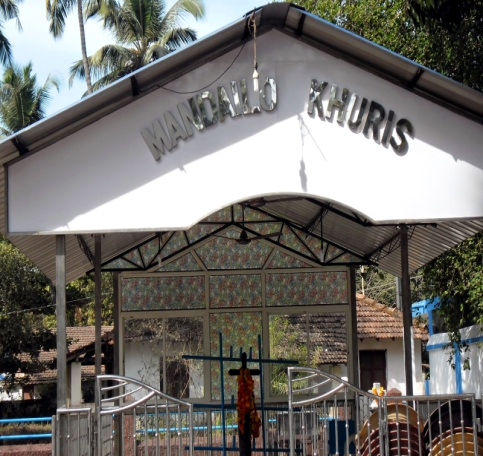
The Candolim Church is dedicated to Our Lady of Hope, called Nossa Senhora da Esperenca Igreja em Candolim in Portuguese. The primitive church here was built in 1560 and repaired and remodeled in 1661. Six years later, the present Candolim church was built on a different site and its two towers were added in 1764. The tower to the left of the Church was destroyed by heavy rains, which was repaired in 1955.
The Pinto Vaddo in Candolim is famous historically because of the Pinto Revolt against the Portuguese and also because it is the birth place and the ancestral home of the world-renowned hypnotist, Abade Faria.
The Candolim villagers celebrate the feast of Our Lady of Agonizante, commonly known as Condoi Saibinnichem Fest in Pinto Vaddo on February 2 at Asilo Chapel, attached to the Asilo or Old Age House for males during the Portuguese times. Opposite the chapel is a century-old ‘Candolim Mand,’ famous for its Manddailo Khuris.
THE HISTORY
The word Manddailo comes from the Konkani word ‘Mandd’, which means a gathering of people for a specific purpose. The Mandd evolved gradually. About a century ago, it is said that some villagers, some say they were ‘kalsaunkar’ (since they wore only short pants), while others say that these were mostly ‘kaxttikars’ (wore only loin cloth) manual labourers of the Vaddo, after working tirelessly in the fields and elsewhere as manual labourers would gather near the house of Chico Bhatkar and discuss issues of their work and other problems.
In course of time, this meeting became a regular affair. Before dispersing, they would make it a point to say a small prayer for their well-being and also for the Vaddo, the village and Goa.
Then, these people started playing the Ghumot music there and hence in course of time, Ghumot music became part of any function organized at the Mandd. The first tiatr at the Mandd was organized on February 2, 1946, on Candoi Saibinnichem fest. The profits made from this were utilised to establish a ‘Death Benefit Fund,’ which was utilised for villagers of Pintos-Araddy Vaddo to purchase coffins.
Later, they brought in a small wooden cross, a quarter of a metre and fixed it on a small piece of coconut tree called ‘Korvo’, about 2 metres in height and around that cross they gathered there for their routine. Through the intercession of this cross, many favours were granted by God, resulting in it acquiring the status of a Miraculous Cross.
Traditionally, as per its history, this Mandd is also known for punishing wrongdoers. It is said that a bhattkar from Bamonn Bhattkarshai, who was jealous of the activities at the Mandd, stopped them. The Mandd people cursed the bhattkar by saying, “Tumguer Sath-Chouda-Ekvis Cheddvanch zaunk” (May you get seven-fourteen-twenty girls). This curse seems to have come true when the bhattkar’s wife gave birth to only girls – seven, in fact. It was only when the bhattkar realized his folly and openly offered his apology to the Mandd that he begot a boy.
The miraculous power of the Manddailo Cross is known all over Goa, hence people from different parts of the State, belonging to different communities throng here with flowers to garland the Cross, to pray and to ask favours from God every day, especially on Sunday mornings. Many also have declared openly and in all humility the miracles in their lives.
THE FEAST
The feast of Manddailo Khuris is celebrated by the administrators of the Mandd on February 2 by staging a tiatr there, which is preceded by playing the traditional Ghumot music. The Ghumot music consists of three traditional instruments, namely Ghumot, Mandyem and Kanxaem, which start from two centres – one in Araddy and the other in Pinto Vaddo.
This music is called Sunvari, coming from two different directions and converges near the Mandd. They recite prayers here and then move towards the Mandd. A short prayer is said for the success of the event, which is followed by a tiatr.
The Manddailo Cross continues to inspire people till today as it has become a source of strength for devotees who seek it in difficult moments, who come for personal favours.
(The writer is former director of Thomas Stephens Konknni Kendr at Porvorim)